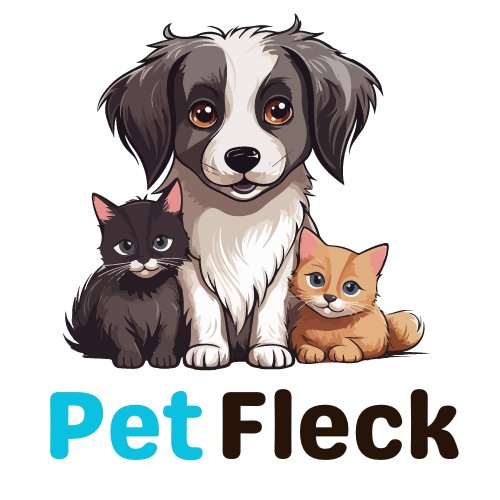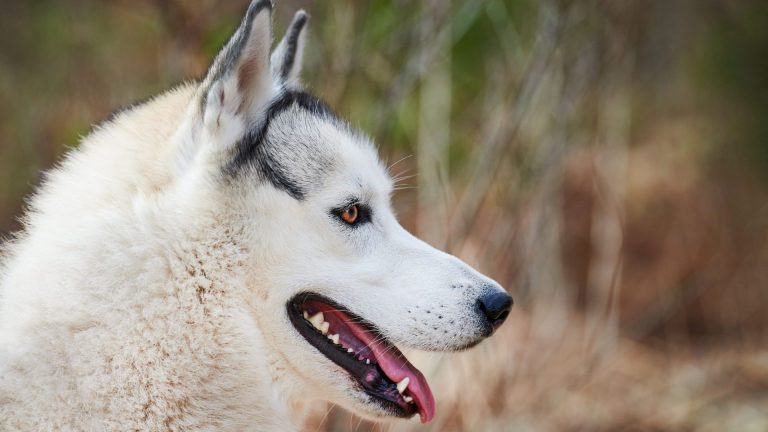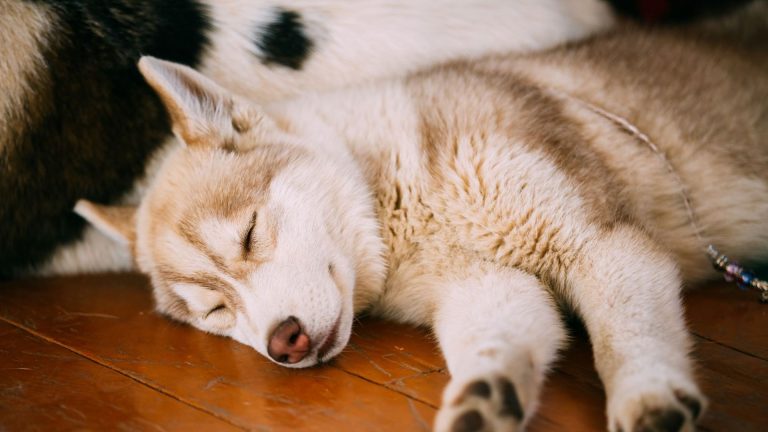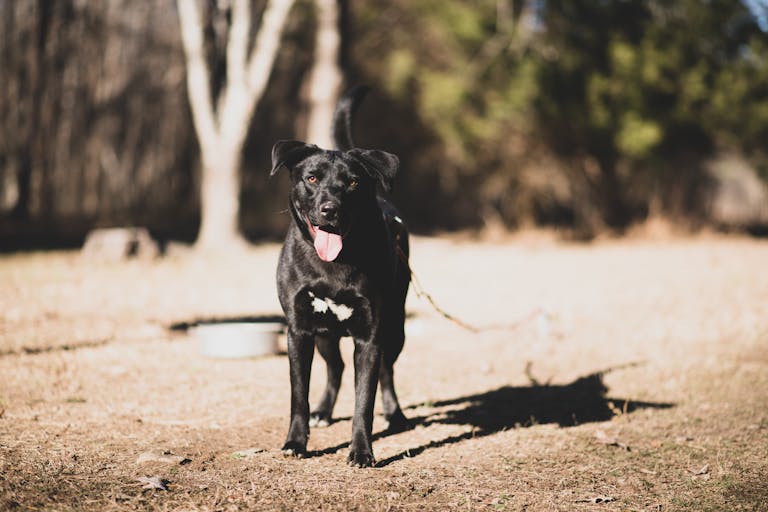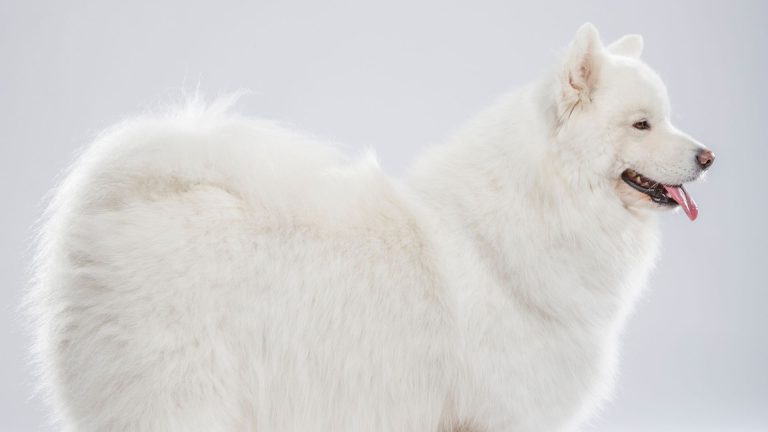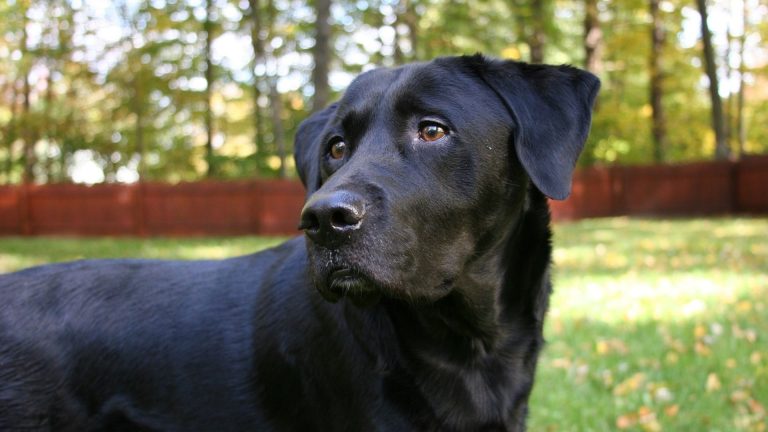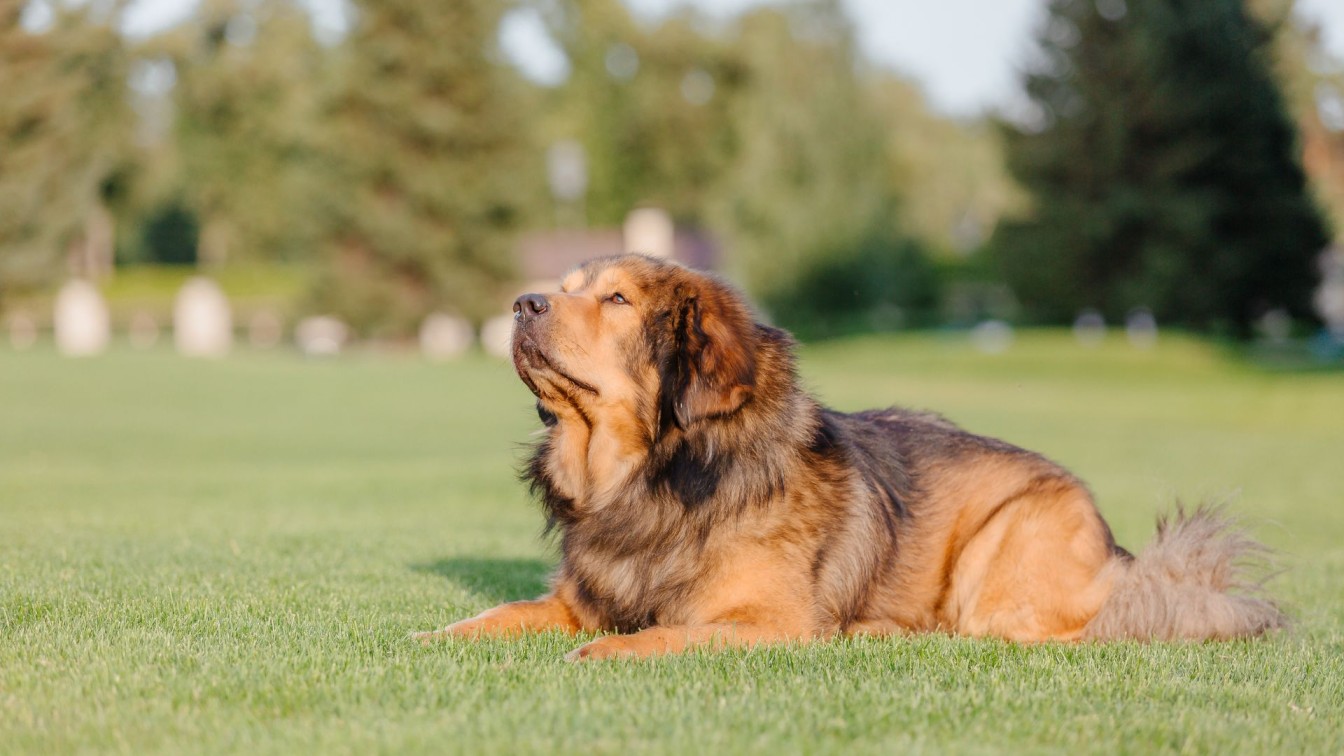
Contents
Large fluffy dog breeds have an undeniable charm. Their soft, voluminous coats invite you to sink your fingers in, offering warmth and comfort. These dogs are not just beautiful; they also have a gentle nature that makes them excellent companions.
Choosing the right breed is crucial for a harmonious relationship between pet and owner. Each breed has unique characteristics, from temperament to grooming needs. Selecting the right dog ensures a happy, fulfilling companionship. It’s not just about looks; it’s about finding a breed that fits your lifestyle and personality.
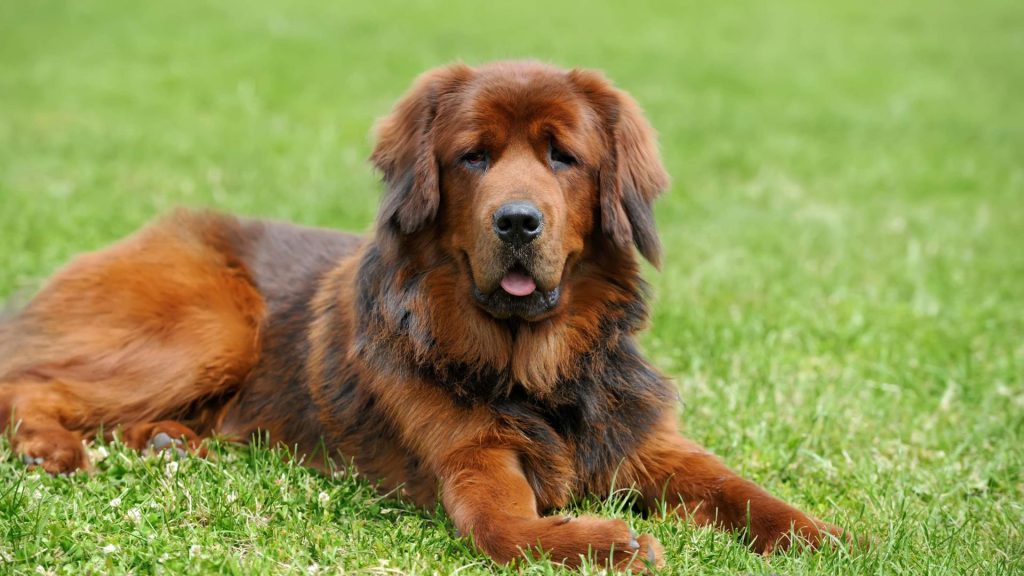
In this article, we will explore the top 10 large fluffy dog breeds. You’ll learn about their origins, physical traits, and personalities. We’ll also discuss their care requirements and why they make great pets. Whether you’re looking for a loyal guardian or a playful friend, this guide will help you find the perfect fluffy companion. Let’s dive into the world of large fluffy dogs and discover which breed might be your new best friend.
1. Newfoundland
The Newfoundland breed originated in Newfoundland, Canada. These dogs were bred to assist fishermen, pulling nets and hauling wood from the forest. Their strong swimming abilities made them invaluable in water rescues. The breed’s history dates back to the 18th century, and they have since become beloved for their hardworking nature and loyalty.
Physical Characteristics
Newfoundlands are large, powerful dogs. Males typically weigh between 130-150 pounds, while females weigh slightly less. They have a thick double coat that is water-resistant, with a soft undercoat and a coarse outer coat. Their coat colors can be black, brown, gray, or Landseer (white with black markings). They have webbed feet, which contribute to their excellent swimming skills.
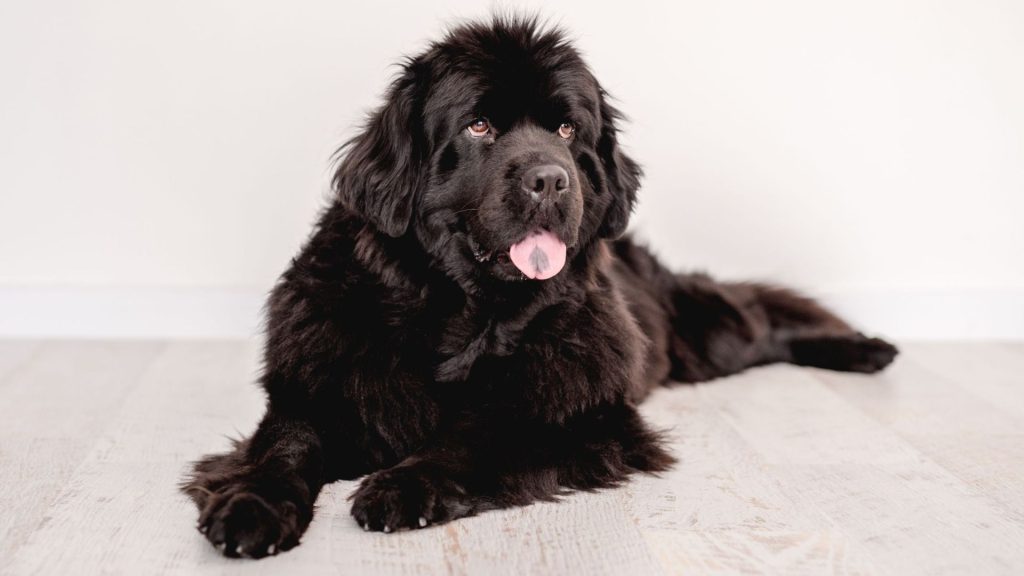
Temperament and Personality
Newfoundlands are known for their gentle and sweet nature. They are incredibly patient and good-natured, making them excellent companions for children. These dogs are also highly intelligent and eager to please, which makes training relatively easy. Despite their size, they are known for their calm demeanor and are often referred to as “gentle giants.”
Care and Grooming Needs
Newfoundlands require regular grooming to keep their coats in good condition. Weekly brushing is essential to prevent matting and reduce shedding. During shedding season, more frequent brushing is needed. Bathing should be done as necessary, but not too frequently to avoid stripping the coat of its natural oils. Regular ear cleaning and nail trimming are also important.
Suitability as a Family Pet
Newfoundlands make excellent family pets. Their gentle and patient nature makes them particularly good with children. They are protective but not aggressive, making them great watchdogs. However, due to their large size, they require plenty of space to move around. They thrive in homes with large yards and benefit from regular exercise to maintain their health. Overall, Newfoundlands are loving, loyal, and make wonderful additions to any family.
2. Bernese Mountain Dog
The Bernese Mountain Dog, originating from the Swiss Alps, has a rich history as a versatile farm dog. Bred by Swiss farmers, these dogs were used for herding cattle, pulling carts, and guarding property. Their history dates back over 2,000 years, with roots tracing to the Roman mastiffs brought to Switzerland. The breed’s name reflects their association with the Bern region.
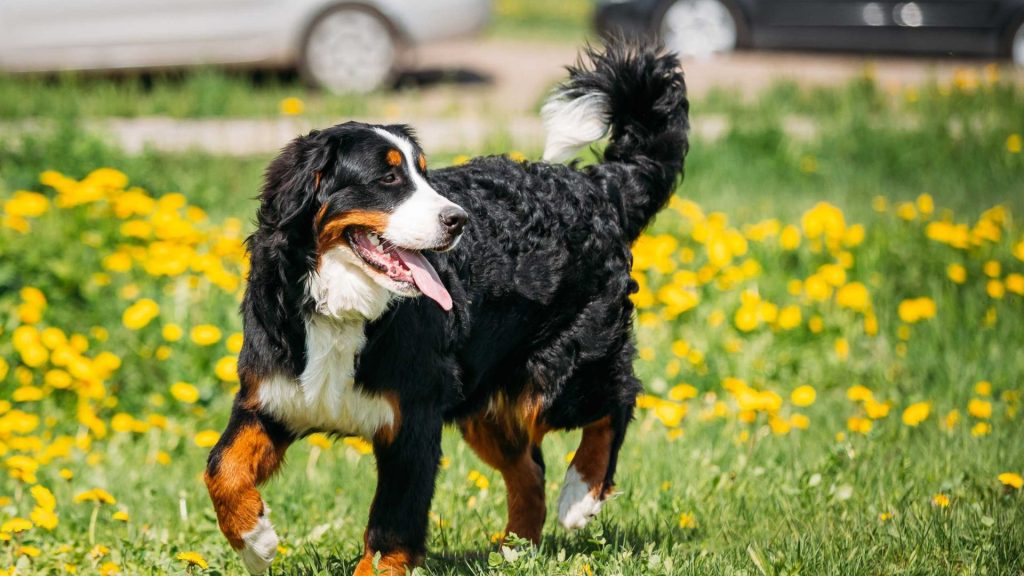
Physical Characteristics
Bernese Mountain Dogs are large, sturdy dogs. Males typically weigh between 85-115 pounds, and females weigh between 70-95 pounds. They have a distinctive tri-color coat, featuring a jet-black base with rust and white markings. Their double coat is thick and slightly wavy, providing insulation against cold weather. These dogs have a strong, muscular build, and their expressive eyes reflect their gentle nature.
Temperament and Personality
Bernese Mountain Dogs are known for their affectionate and friendly demeanor. They are loyal and devoted to their families, often forming strong bonds with their owners. These dogs are also known for their gentle temperament, making them excellent companions for children. Despite their large size, they are typically calm and easygoing. However, they can be a bit reserved around strangers, though not aggressive.
Care and Grooming Needs
Bernese Mountain Dogs require regular grooming to keep their coats healthy. Weekly brushing is essential to manage shedding and prevent matting. During shedding seasons, more frequent brushing is necessary. Bathing should be done as needed, and regular ear cleaning and nail trimming are important. These dogs also need ample exercise to maintain their health, including daily walks and playtime.
Suitability as a Family Pet
Bernese Mountain Dogs make wonderful family pets due to their gentle and affectionate nature. They are particularly good with children and get along well with other pets. Their protective instincts make them reliable watchdogs. However, they need space to move around and benefit from a home with a large yard. They thrive on companionship and do best in households where they can be an active part of family life. Overall, Bernese Mountain Dogs are loyal, loving, and make excellent additions to any family.
3. Samoyed
The Samoyed breed originated in Siberia, where they were bred by the Samoyedic people. These dogs were used for herding reindeer, pulling sleds, and keeping their owners warm in the harsh Arctic climate. Their history dates back over a thousand years, making them one of the oldest and most resilient dog breeds. Samoyeds were later brought to Europe and America in the late 19th and early 20th centuries, where they quickly became popular for their beauty and friendly nature.
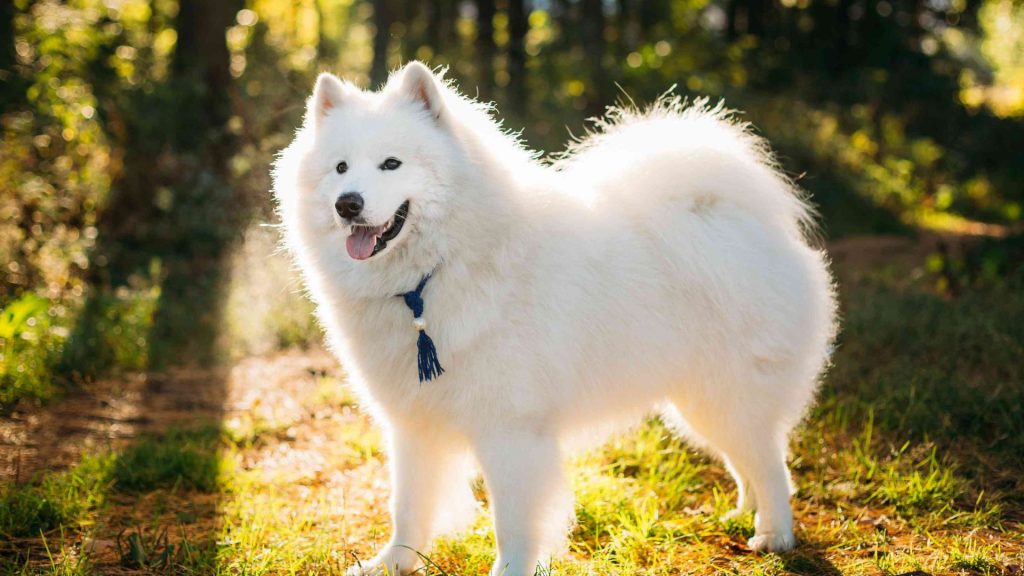
Physical Characteristics
Samoyeds are medium to large-sized dogs, with males weighing between 45-65 pounds and females weighing 35-50 pounds. They are known for their thick, fluffy, white double coat, which provides excellent insulation against the cold. Their coat is dense and stands out from the body, giving them a distinctive, cloud-like appearance. They have dark, almond-shaped eyes and a characteristic “Sammy smile,” which gives them a friendly and inviting expression.
Temperament and Personality
Samoyeds are known for their friendly and sociable nature. They are highly affectionate and enjoy being around people, making them excellent family pets. These dogs are playful, energetic, and intelligent, which makes them great companions for active families. They are also known for their gentle and patient demeanor, making them good with children. Samoyeds are alert and can be good watchdogs, though they are generally not aggressive.
Care and Grooming Needs
Samoyeds require regular grooming to maintain their beautiful coat. Daily brushing is recommended to prevent matting and reduce shedding. During shedding season, more frequent brushing is necessary. Bathing should be done as needed, but not too frequently, as it can strip the coat of its natural oils. Regular ear cleaning and nail trimming are also important. Samoyeds are active dogs that need plenty of exercise, including daily walks and playtime.
Suitability as a Family Pet
Samoyeds make excellent family pets due to their friendly and loving nature. They are particularly good with children and get along well with other pets. These dogs thrive on companionship and do best in households where they can be an active part of family life. They require space to move around and benefit from a home with a yard. Samoyeds are known for their loyalty and are sure to bring joy and warmth to any family.
4. Alaskan Malamute
The Alaskan Malamute is one of the oldest Arctic sled dog breeds. Originating from Alaska, they were developed by the Mahlemut tribe of Inuit people. These dogs were bred for their strength and endurance, primarily used for pulling heavy sleds over long distances. Their history spans thousands of years, and they played a crucial role in the survival of the Inuit people by aiding in transportation and hunting.
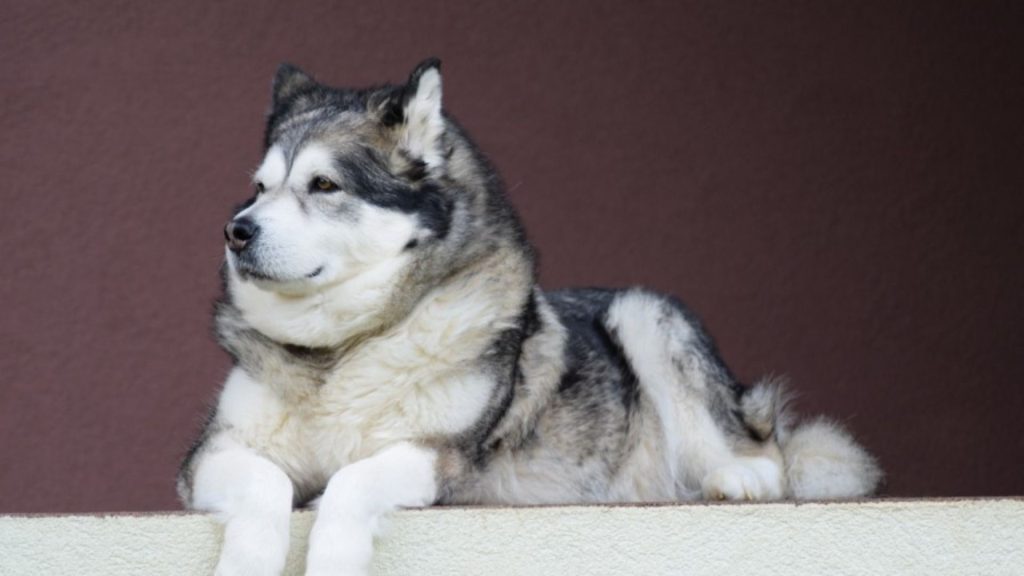
Physical Characteristics
Alaskan Malamutes are large, powerful dogs. Males typically weigh between 85-100 pounds, while females weigh slightly less. They have a thick double coat, with a dense, woolly undercoat and a coarse, weather-resistant outer coat. Their coat colors range from light gray to black, often with white markings on the face, chest, and legs. They have a broad head, erect ears, and a bushy tail that curls over their back.
Temperament and Personality
Alaskan Malamutes are known for their friendly and affectionate nature. They are highly social and enjoy being around people, making them excellent family pets. These dogs are also very intelligent and independent, which can sometimes translate to a stubborn streak. They are playful and energetic, requiring regular exercise to stay happy and healthy. Malamutes are also known for their loyalty and protective instincts, making them good watchdogs.
Care and Grooming Needs
Alaskan Malamutes require regular grooming to keep their coats in good condition. Weekly brushing is essential to prevent matting and reduce shedding. During shedding seasons, more frequent brushing is necessary. Bathing should be done as needed, but not too often to avoid stripping the coat of its natural oils. Regular ear cleaning and nail trimming are also important. These dogs need plenty of exercise, including daily walks and playtime, to maintain their physical and mental health.
Suitability as a Family Pet
Alaskan Malamutes make excellent family pets for active households. Their friendly and affectionate nature makes them particularly good with children. They get along well with other pets, though their strong prey drive means early socialization is important. Malamutes require plenty of space to move around and benefit from a home with a large yard. They thrive on companionship and do best in households where they can be an integral part of family activities. Overall, Alaskan Malamutes are loyal, loving, and make wonderful additions to active families.
5. Great Pyrenees
The Great Pyrenees, also known as the Pyrenean Mountain Dog, has its origins in the Pyrenees Mountains of France and Spain. Bred as a livestock guardian dog, they have protected sheep from predators for centuries. Their history dates back to around 1800 B.C., and they were favored by French nobility in the 17th century for their majestic appearance and loyal nature.
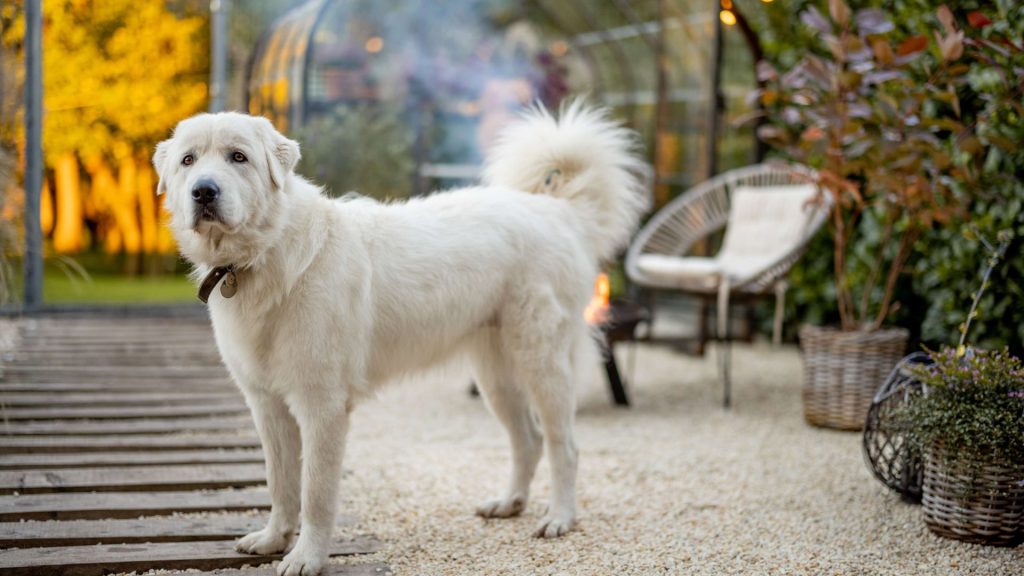
Physical Characteristics
Great Pyrenees are large, majestic dogs. Males typically weigh between 100-120 pounds, while females weigh 85-100 pounds. They have a thick, weather-resistant double coat, with a dense, woolly undercoat and a long, coarse outer coat. Their coat is usually white, sometimes with patches of gray, badger, or tan. They have a strong, muscular build, a broad head, and dark, expressive eyes that convey their gentle nature.
Temperament and Personality
Great Pyrenees are known for their calm and patient demeanor. They are gentle giants, displaying a protective and nurturing nature, especially towards children and livestock. These dogs are also independent and strong-willed, traits developed from their history as solitary guardians. While they are typically reserved around strangers, they are affectionate and loyal to their families. Their intelligence and guardian instincts make them excellent watchdogs.
Care and Grooming Needs
Great Pyrenees require regular grooming to maintain their beautiful coat. Weekly brushing is necessary to prevent matting and reduce shedding. During shedding seasons, more frequent brushing is needed. Bathing should be done as required, and regular ear cleaning and nail trimming are important to maintain overall health. These dogs need moderate exercise, including daily walks and playtime, to stay healthy and happy.
Suitability as a Family Pet
Great Pyrenees make excellent family pets for those with enough space and time to care for them. Their gentle and protective nature makes them particularly good with children and other pets. They require a home with a large yard where they can roam and patrol. These dogs thrive on companionship and do best in households where they can be an integral part of the family. With their loyalty, patience, and protective instincts, Great Pyrenees are wonderful additions to families who can meet their needs.
6. Tibetan Mastiff
The Tibetan Mastiff hails from the mountainous regions of Tibet, where they have been used for centuries as guardian dogs. Bred by nomadic cultures of Tibet, China, Nepal, and India, these dogs protected livestock from predators such as wolves and leopards. Their history dates back thousands of years, and they are considered one of the oldest and most primitive dog breeds. Tibetan Mastiffs were often kept by Tibetan monasteries and were highly valued for their protective instincts and imposing presence.
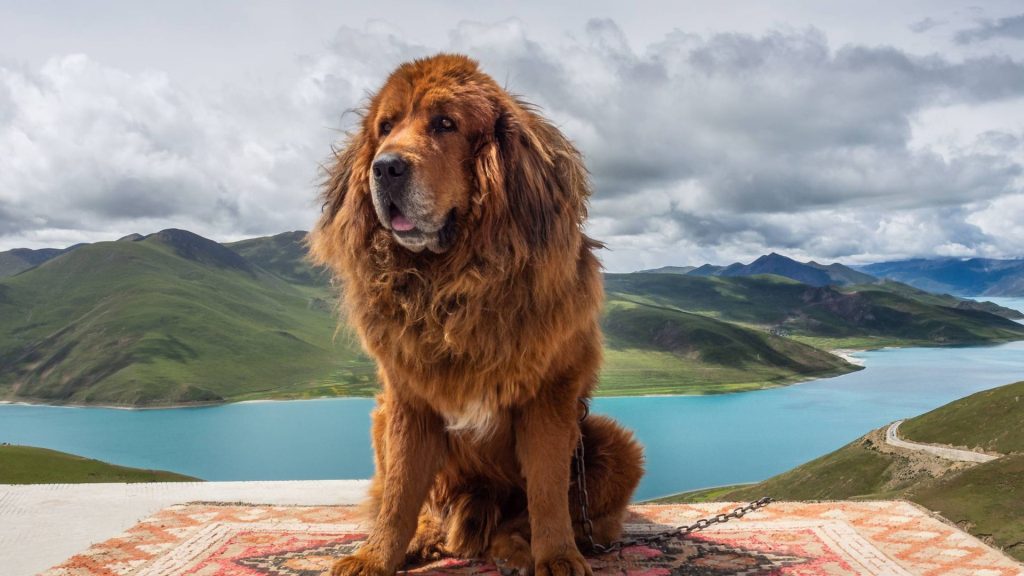
Physical Characteristics
Tibetan Mastiffs are large, powerful dogs. Males can weigh between 90-150 pounds, while females typically weigh 70-120 pounds. They have a thick double coat that provides excellent protection against harsh weather conditions. Their coat colors can include black, brown, blue-gray, or gold, often with tan markings. They possess a broad head, strong jaws, and a bushy tail that curls over their back. Their imposing size and lion-like mane give them a majestic appearance.
Temperament and Personality
Tibetan Mastiffs are known for their independence and strong-willed nature. They are highly protective of their family and property, making them excellent guard dogs. These dogs are loyal and devoted to their families but can be aloof with strangers. They are intelligent and can be quite stubborn, requiring a firm and consistent approach to training. Tibetan Mastiffs are calm and patient but can be fierce when they perceive a threat.
Care and Grooming Needs
Tibetan Mastiffs require regular grooming to keep their thick coats in good condition. Weekly brushing is necessary to prevent matting and manage shedding. During shedding season, more frequent brushing is needed. Bathing should be done as needed, but not too often to avoid stripping the coat of natural oils. Regular ear cleaning and nail trimming are also important. These dogs need moderate exercise, including daily walks and time to roam in a secure area.
Suitability as a Family Pet
Tibetan Mastiffs can make excellent family pets for experienced dog owners who understand their unique needs. Their protective nature makes them good with children, though supervision is recommended due to their size and strength. They do best in homes with large, securely fenced yards where they can patrol and exercise. Tibetan Mastiffs thrive on companionship and should be included in family activities. With proper training, socialization, and care, they can be loyal and loving members of the family.
7. Chow Chow
The Chow Chow is an ancient breed originating from northern China. Known for their unique appearance and dignified demeanor, they were used for hunting, herding, pulling carts, and guarding. The breed’s history dates back more than 2,000 years, with evidence suggesting they may be one of the oldest dog breeds in existence. Chows were highly valued by Chinese emperors and nobility, contributing to their long-standing reputation as prestigious companions.
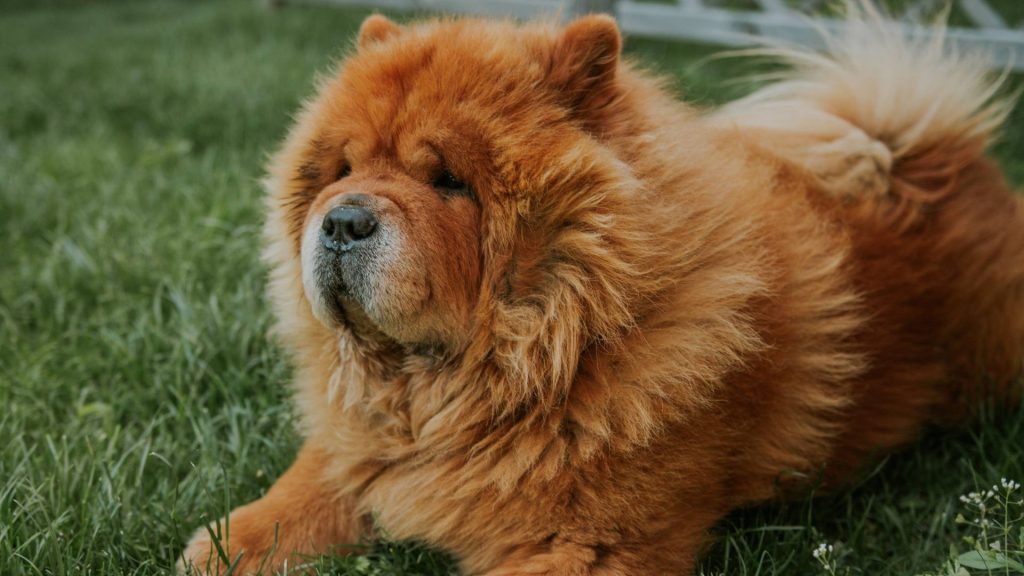
Physical Characteristics
Chow Chows are medium-sized dogs with a distinctive lion-like mane. Males typically weigh between 55-70 pounds, and females weigh 45-60 pounds. They have a thick double coat that can be either rough or smooth, with colors including red, black, blue, cinnamon, and cream. One of their most notable features is their blue-black tongue. They have a broad, flat skull, deep-set almond-shaped eyes, and small, erect ears. Their sturdy build and distinctive, stiff-legged gait add to their unique appearance.
Temperament and Personality
Chow Chows are known for their aloof and independent nature. They are often described as cat-like due to their reserved and dignified demeanor. These dogs are loyal and protective of their families but can be wary of strangers. Early socialization is crucial to ensure they are well-adjusted and not overly suspicious. Chows are intelligent but can be stubborn, requiring consistent and patient training. Despite their independent streak, they form strong bonds with their families and can be very affectionate with their loved ones.
Care and Grooming Needs
Chow Chows require regular grooming to maintain their thick coats. Weekly brushing is essential to prevent matting and reduce shedding, with more frequent brushing needed during shedding seasons. Bathing should be done as needed, and it’s important to thoroughly dry their dense coat to avoid skin issues. Regular ear cleaning, nail trimming, and dental care are also necessary. Chows need moderate exercise, including daily walks and playtime, to keep them physically and mentally stimulated.
Suitability as a Family Pet
Chow Chows can make excellent family pets for those who understand and appreciate their unique traits. They are best suited for families with older children who can respect their space. While they can be good with other pets if raised with them, their natural aloofness may make them less social than other breeds. Chows thrive in a calm, stable environment and do well in homes with a yard where they can patrol. With proper training, socialization, and care, Chow Chows can be loyal, protective, and loving companions.
8. Leonberger
The Leonberger breed originated in Leonberg, Germany, in the 19th century. Heinrich Essig, a politician and entrepreneur, developed the breed by crossing Newfoundlands, Saint Bernards, and Great Pyrenees. Essig aimed to create a dog that resembled a lion, symbolizing the town’s crest. The breed quickly gained popularity across Europe for its impressive size, beauty, and versatility. Leonbergers were used for various tasks, including guarding farms and pulling carts. They almost faced extinction during the World Wars but were revived by dedicated breeders.
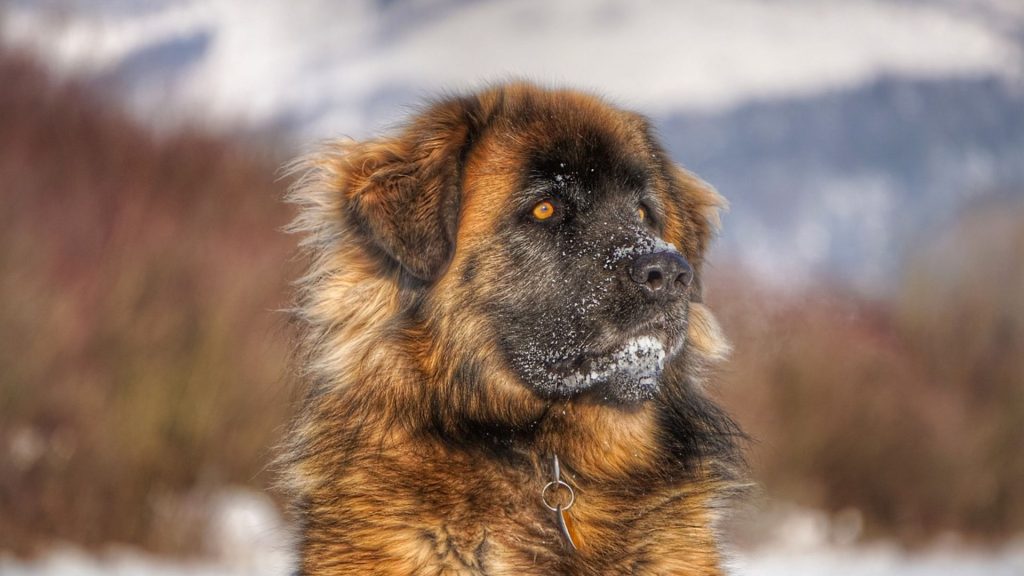
Physical Characteristics
Leonbergers are large, muscular dogs. Males typically weigh between 110-170 pounds, while females weigh 90-140 pounds. They have a dense, water-resistant double coat that comes in shades of lion-yellow, red, red-brown, and sandy, often with a black mask. Their expressive, dark brown eyes convey intelligence and kindness. Leonbergers have a strong, balanced build with a slightly arched neck, broad chest, and a bushy tail that hangs down.
Temperament and Personality
Leonbergers are known for their friendly and gentle temperament. They are affectionate and loyal, forming strong bonds with their families. These dogs are patient and good-natured, making them excellent companions for children. Despite their large size, they are calm and well-mannered indoors. Leonbergers are intelligent and eager to please, which makes training relatively straightforward. They are also alert and protective, making them reliable watchdogs without being aggressive.
Care and Grooming Needs
Leonbergers require regular grooming to keep their coat healthy and reduce shedding. Weekly brushing is necessary to prevent matting and tangles. During shedding season, more frequent brushing is needed. Bathing should be done as required, and thorough drying is essential to prevent skin issues. Regular ear cleaning, nail trimming, and dental care are also important. Leonbergers need moderate exercise, including daily walks, playtime, and opportunities to swim, which they enjoy.
Suitability as a Family Pet
Leonbergers make excellent family pets for those who can accommodate their size and grooming needs. Their gentle and patient nature makes them particularly good with children and other pets. They thrive in a home environment where they can be an integral part of family activities. A large yard is beneficial for them to exercise and play. Leonbergers are social dogs that require companionship and do best in households where they are not left alone for long periods. With their loving, protective, and loyal nature, Leonbergers are wonderful additions to families who can meet their needs.
9. Old English Sheepdog
The Old English Sheepdog, often affectionately called the “Bobtail” due to its docked tail, originated in England in the early 19th century. Initially bred to herd sheep and cattle, these dogs were valued for their intelligence, agility, and herding instincts. The breed’s ancestors likely include the Bearded Collie and various European herding dogs. Over time, the Old English Sheepdog transitioned from a working dog to a beloved family companion, known for its distinctive appearance and gentle nature.
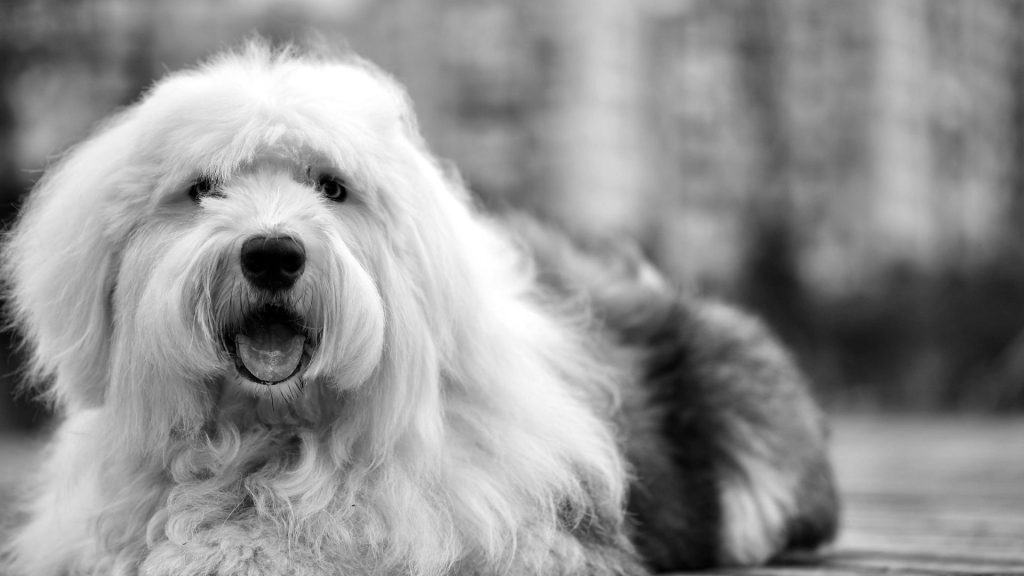
Physical Characteristics
Old English Sheepdogs are large, robust dogs. Males typically weigh between 70-100 pounds, while females weigh 60-85 pounds. They are famous for their long, thick, double coat that can be either straight or wavy. The coat colors are usually blue-gray, blue merle, or gray, often with white markings. Their shaggy coat covers their eyes, giving them a distinctive, endearing appearance. They have a sturdy build, a large head, and a short, square muzzle.
Temperament and Personality
Old English Sheepdogs are known for their gentle, friendly, and playful nature. They are affectionate and loyal to their families, making them excellent companions. These dogs are intelligent and have a strong herding instinct, which can sometimes manifest in gentle nudging or herding behaviors with children and other pets. They are generally good-natured and get along well with strangers. Their playful and energetic disposition makes them great playmates for children.
Care and Grooming Needs
Old English Sheepdogs require extensive grooming to maintain their thick coat. Daily brushing is essential to prevent matting and tangles. Regular professional grooming is often necessary to keep their coat in good condition. Bathing should be done as needed, and it’s important to thoroughly dry their coat to prevent skin issues. Regular ear cleaning, nail trimming, and dental care are also crucial. These dogs need moderate exercise, including daily walks and playtime, to stay healthy and happy.
Suitability as a Family Pet
Old English Sheepdogs make wonderful family pets for those who can commit to their grooming needs. Their gentle and playful nature makes them particularly good with children and other pets. They thrive in a home environment where they can be an active part of family life. A yard for them to play in is beneficial, but they can adapt to various living situations if given enough exercise. Old English Sheepdogs are social dogs that require companionship and do best in households where they are not left alone for long periods. With their loving, playful, and loyal nature, Old English Sheepdogs are a delightful addition to any family.
10. Keeshond
The Keeshond, pronounced “kayz-hawnd,” has its origins in the Netherlands, where it served as a barge dog on Dutch canal boats. Known as the “Dutch Barge Dog,” the breed was popular among Dutch patriots during the 18th century, especially as a symbol of the Dutch Patriot political party led by Cornelis (Kees) de Gyselaer. The breed’s history dates back several centuries, and it has always been cherished for its companionship and alert nature.
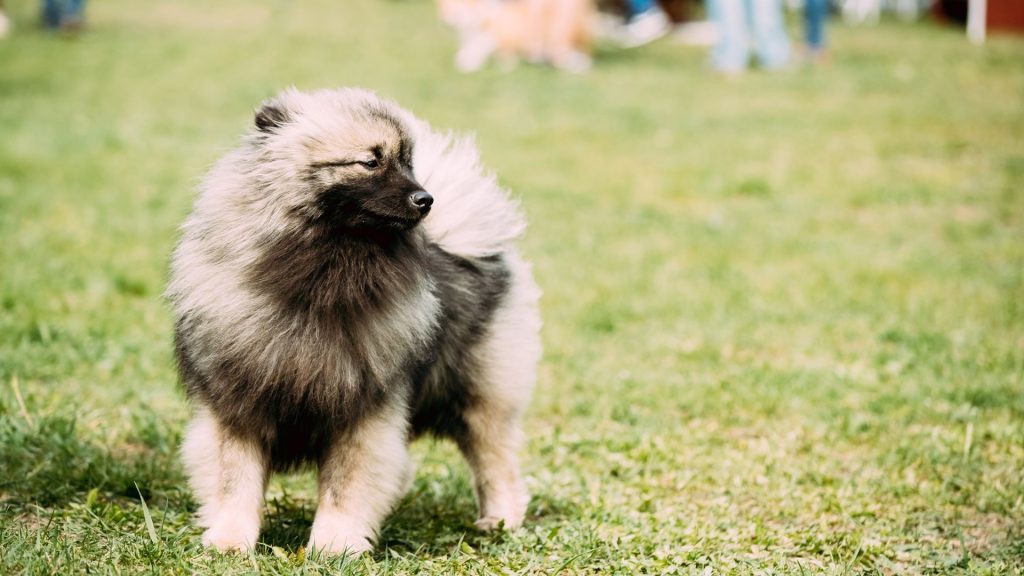
Physical Characteristics
Keeshonden are medium-sized dogs, with males typically weighing between 35-45 pounds and females weighing 30-40 pounds. They have a distinctive double coat, with a thick, downy undercoat and a longer, harsher outer coat. The coat color is a mix of gray, black, and cream, with characteristic “spectacles” around their eyes, giving them an expressive, intelligent look. They have a fox-like face, erect ears, and a bushy tail that curls over their back.
Temperament and Personality
Keeshonden are known for their friendly, outgoing, and lively nature. They are highly affectionate and form strong bonds with their families. These dogs are intelligent and quick learners, making training enjoyable and relatively easy. Keeshonden are naturally alert and make excellent watchdogs, although they are not aggressive. They are sociable dogs that get along well with children, other pets, and even strangers, making them ideal family companions.
Care and Grooming Needs
Keeshonden require regular grooming to maintain their beautiful coat. Weekly brushing is necessary to prevent matting and reduce shedding. During shedding seasons, more frequent brushing is needed. Bathing should be done as required, ensuring the coat is thoroughly dried to prevent skin issues. Regular ear cleaning, nail trimming, and dental care are also important. Keeshonden need moderate exercise, including daily walks and playtime, to stay healthy and happy. They also enjoy mental stimulation through interactive games and training.
Suitability as a Family Pet
Keeshonden make excellent family pets due to their friendly and affectionate nature. They are particularly good with children and get along well with other pets. These dogs thrive on companionship and do best in households where they can be an active part of family life. They adapt well to various living situations, including apartments, as long as they receive sufficient exercise and mental stimulation. With their loving, playful, and loyal nature, Keeshonden are delightful additions to any family.
Conclusion
Large fluffy dog breeds offer unparalleled companionship, warmth, and loyalty. Their gentle nature and affectionate demeanor make them ideal family pets. However, it’s crucial to choose a breed that matches your lifestyle and preferences to ensure a harmonious relationship. Consider factors like grooming needs, exercise requirements, and temperament when making your choice. Each breed has its unique traits and charms, so explore our website to learn more about these wonderful dogs and find the perfect fluffy companion for your family. Embrace the joy and love that a large fluffy dog can bring into your life.

Hello, I’m Donna Carter, the founder and writer behind PetFleck.com. My journey with dogs started years ago, and it’s been a passion that has only grown stronger over time. I’ve always been fascinated by the unique behaviors and characteristics of different dog breeds, and this curiosity has led me to dive deep into the world of canine studies.
My love for dogs is the driving force behind everything I do. I’ve dedicated countless hours to researching and understanding the nuances of dog care, training, and breed-specific traits. This dedication helps me create content that is not only informative but also genuinely helpful for fellow dog lovers and owners.
At PetFleck, I combine my extensive knowledge and hands-on experience with my passion for dogs to provide valuable insights and tips. Whether it’s exploring different breeds or offering practical advice on dog care, I aim to share knowledge that makes a real difference in the lives of dogs and their families.
I’m thrilled to share my love for dogs with you through my writing. I hope my articles inspire and inform, helping you to better understand and appreciate the incredible bond we share with our furry friends.
Thank you for visiting PetFleck.com, and I look forward to connecting with you through our shared love of dogs!
